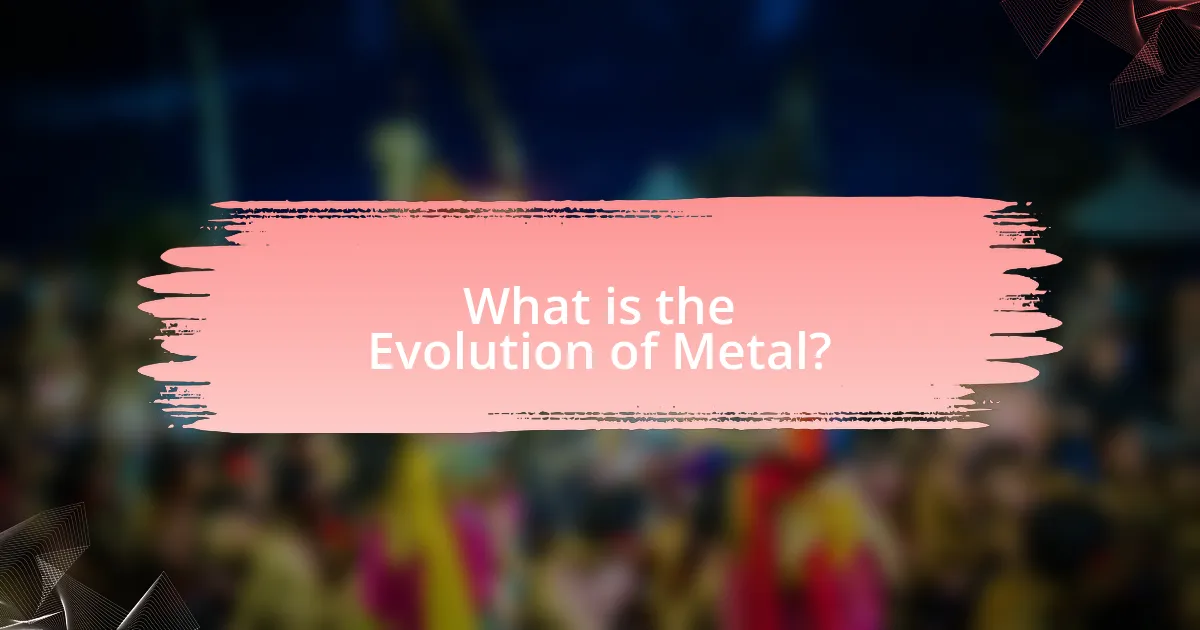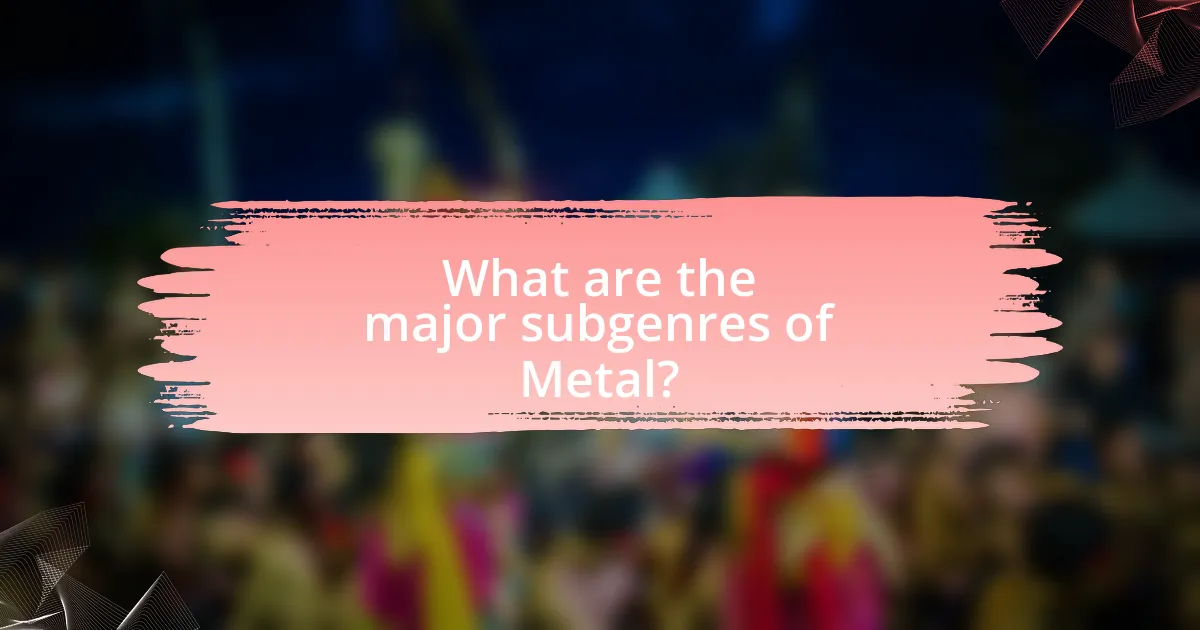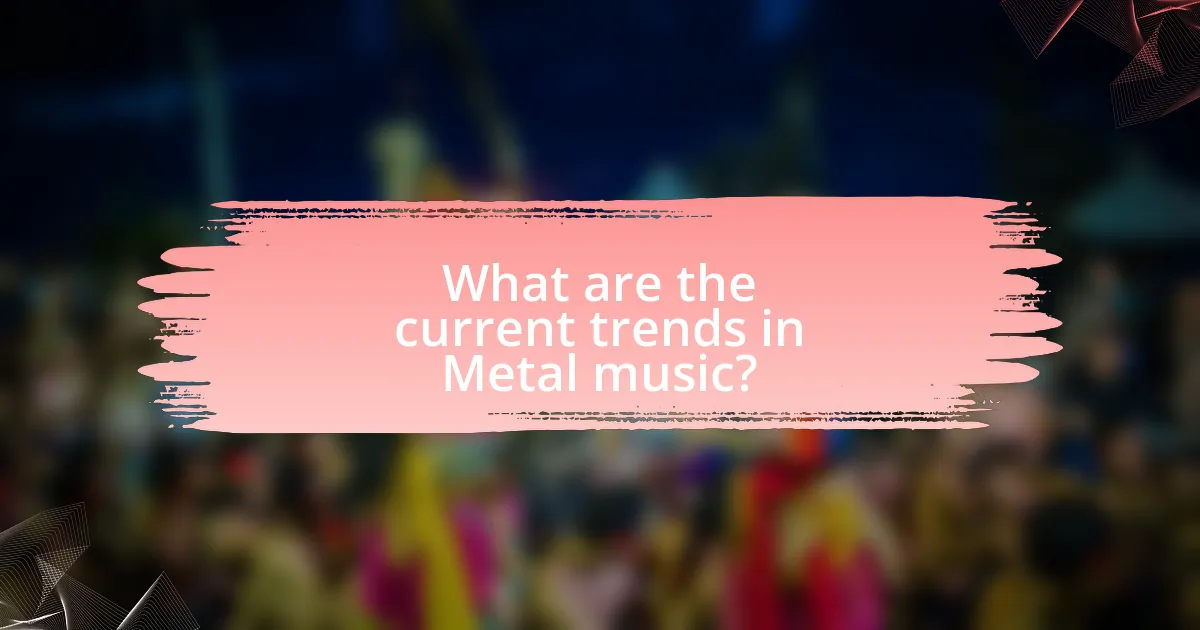The article examines the evolution of metal music, tracing its origins from the late 1960s and early 1970s with pioneering bands like Black Sabbath and Led Zeppelin, who established the heavy metal sound characterized by distorted guitars and powerful vocals. It explores the emergence of various subgenres throughout the decades, including thrash metal, nu-metal, and metalcore, highlighting the influence of cultural, technological, and musical factors on the genre’s development. Additionally, the article discusses the impact of streaming and social media on contemporary metal culture, as well as the future prospects for the genre, emphasizing the importance of fan engagement and the ongoing diversification of metal music.

What is the Evolution of Metal?
The evolution of metal music began in the late 1960s and early 1970s, characterized by the emergence of heavy metal bands like Black Sabbath and Led Zeppelin, which combined blues rock with darker themes and heavier instrumentation. This foundational period established the genre’s signature sound, marked by distorted guitars, powerful vocals, and emphatic drumming.
As the genre progressed through the 1980s, various subgenres emerged, including thrash metal, pioneered by bands like Metallica and Slayer, which introduced faster tempos and aggressive riffs. The 1990s saw the rise of alternative metal and nu-metal, with bands such as Korn and Rage Against the Machine blending metal with other genres like hip-hop and grunge, further diversifying the sound.
In the 2000s and beyond, metal continued to evolve with the introduction of subgenres like metalcore and progressive metal, featuring complex song structures and a mix of clean and harsh vocals, exemplified by bands like Killswitch Engage and Dream Theater. This ongoing evolution reflects the genre’s adaptability and the influence of various musical styles, ensuring its relevance in contemporary music culture.
How did Heavy Metal originate?
Heavy Metal originated in the late 1960s and early 1970s as a distinct genre of rock music characterized by amplified distortion, extended guitar solos, and emphatic beats. Bands such as Black Sabbath and Led Zeppelin played pivotal roles in shaping the sound and style of Heavy Metal, with Black Sabbath’s self-titled debut album in 1970 often cited as one of the first true Heavy Metal records. The genre drew influences from earlier rock and blues music, incorporating heavier guitar riffs and darker themes, which set it apart from its predecessors.
What are the key characteristics of Heavy Metal music?
Heavy Metal music is characterized by its aggressive sound, heavy use of distorted electric guitars, and powerful drumming. The genre typically features fast tempos, complex guitar solos, and emphatic rhythms, which contribute to its intense auditory experience. Lyrically, Heavy Metal often explores themes of rebellion, fantasy, and social issues, reflecting a countercultural ethos. Historically, bands like Black Sabbath and Led Zeppelin laid the groundwork for the genre in the late 1960s and early 1970s, establishing the foundational elements that define Heavy Metal today.
Who were the pioneering bands in Heavy Metal?
The pioneering bands in Heavy Metal include Black Sabbath, Led Zeppelin, and Deep Purple. Black Sabbath, often credited as the first true heavy metal band, released their self-titled debut album in 1970, which featured dark themes and heavy guitar riffs. Led Zeppelin, with their 1969 album “Led Zeppelin,” incorporated blues and rock elements that influenced the heavy metal sound. Deep Purple’s 1970 album “In Rock” is also considered a significant contribution to the genre, showcasing powerful vocals and intricate instrumentation. These bands laid the foundation for the heavy metal genre, shaping its sound and style.
What factors contributed to the evolution of Metal music?
The evolution of Metal music was primarily influenced by cultural, technological, and musical factors. Cultural shifts in the late 1960s and early 1970s, including the counterculture movement and the rise of youth rebellion, provided a fertile ground for the emergence of heavier sounds. Technological advancements, such as the development of electric guitars and amplifiers, allowed for greater distortion and volume, which became hallmarks of the genre. Musically, the fusion of blues rock, psychedelic rock, and early hard rock laid the foundation for Metal, with bands like Black Sabbath and Led Zeppelin pioneering the sound. The emergence of subgenres in the 1980s, such as thrash, death, and black metal, further diversified the genre, driven by bands like Metallica, Slayer, and Venom, which expanded the thematic and stylistic boundaries of Metal music.
How did cultural and social changes influence Metal’s development?
Cultural and social changes significantly influenced Metal’s development by shaping its themes, aesthetics, and audience engagement. The genre emerged in the late 1960s and early 1970s, reflecting societal upheavals such as the counterculture movement, which emphasized rebellion against authority and traditional norms. This context led to the incorporation of darker themes and aggressive sounds in Metal, as bands like Black Sabbath and Led Zeppelin drew inspiration from societal discontent and personal struggles.
Furthermore, the rise of youth culture and the increasing prominence of rock music as a form of expression allowed Metal to flourish. The genre’s evolution into various subgenres, such as Thrash and Death Metal in the 1980s, was also a response to cultural shifts, including the rise of punk and the desire for more extreme forms of music. The globalization of music in the late 20th century further diversified Metal, as bands from different countries infused their cultural backgrounds into the genre, leading to the emergence of styles like Scandinavian Black Metal.
Thus, cultural and social changes have been pivotal in shaping Metal’s identity, driving its evolution and expansion into a multifaceted genre that continues to resonate with audiences worldwide.
What role did technology play in the evolution of Metal?
Technology significantly influenced the evolution of Metal by enabling advancements in sound production, distribution, and performance. The introduction of electric guitars in the 1950s allowed for heavier and more distorted sounds, which became foundational in the genre. Additionally, the development of multi-track recording in the 1960s and 1970s facilitated complex arrangements and layering of instruments, enhancing the overall sound quality. The rise of digital technology in the 1980s further transformed Metal, allowing for the use of synthesizers and computer-generated effects, which expanded the genre into various subgenres like thrash, death, and nu-metal. Furthermore, the internet revolutionized music distribution, enabling underground bands to reach wider audiences and fostering the growth of diverse Metal communities globally.
Why is understanding the evolution of Metal important?
Understanding the evolution of Metal is important because it provides insight into the genre’s cultural impact and musical diversity. The progression from early heavy metal in the late 1960s and 1970s, characterized by bands like Black Sabbath and Led Zeppelin, to the emergence of various subgenres such as thrash, death, and power metal illustrates how societal changes and technological advancements influenced musical styles. This evolution reflects broader trends in music, including shifts in lyrical themes, instrumentation, and fan communities, highlighting Metal’s role in shaping contemporary music culture.
How does the evolution of Metal reflect broader musical trends?
The evolution of Metal reflects broader musical trends by showcasing the genre’s adaptability and incorporation of diverse influences over time. Initially rooted in blues and rock, Heavy Metal emerged in the late 1960s and early 1970s, characterized by its heavy guitar riffs and powerful vocals, paralleling the rise of countercultural movements. As Metal progressed into the 1980s and 1990s, subgenres like Thrash, Death, and Black Metal emerged, mirroring the increasing complexity and experimentation seen in other genres such as Punk and Progressive Rock. This diversification within Metal illustrates a response to societal changes, technological advancements in music production, and the globalization of musical styles, reflecting a broader trend of genre blending and innovation across the music industry.
What impact has the evolution of Metal had on contemporary music?
The evolution of Metal has significantly influenced contemporary music by introducing diverse subgenres and innovative musical techniques. This genre has expanded the boundaries of rock music, leading to the incorporation of complex rhythms, heavy guitar riffs, and aggressive vocal styles in various contemporary genres such as pop, hip-hop, and electronic music. For instance, artists like Linkin Park and Bring Me The Horizon have blended Metal elements with mainstream pop, creating a crossover appeal that has garnered widespread popularity. Additionally, the technical proficiency and production techniques developed within Metal have set new standards for musicians across genres, impacting songwriting and performance practices.

What are the major subgenres of Metal?
The major subgenres of Metal include Heavy Metal, Thrash Metal, Death Metal, Black Metal, Power Metal, and Progressive Metal. Heavy Metal, characterized by its loud, aggressive sound and powerful guitar riffs, emerged in the late 1960s and early 1970s with bands like Black Sabbath. Thrash Metal, which developed in the 1980s, combines elements of speed metal and hardcore punk, exemplified by bands such as Metallica and Slayer. Death Metal, known for its heavy use of distorted guitars and growled vocals, gained prominence in the late 1980s with bands like Death and Cannibal Corpse. Black Metal, characterized by its dark themes and lo-fi production, emerged in the early 1990s with bands like Mayhem and Burzum. Power Metal, which emphasizes melodic elements and fantasy themes, became popular in the late 1980s and 1990s with bands like Helloween and Blind Guardian. Progressive Metal, known for its complex structures and musicianship, features bands like Dream Theater and Tool, emerging in the late 1980s. Each subgenre has distinct characteristics and has contributed to the overall evolution of Metal music.
How do different subgenres of Metal compare to Heavy Metal?
Different subgenres of Metal, such as Thrash Metal, Death Metal, and Black Metal, exhibit distinct characteristics that differentiate them from Heavy Metal. Thrash Metal, for instance, incorporates faster tempos and aggressive guitar riffs, exemplified by bands like Metallica and Slayer, which contrasts with the more melodic and slower-paced nature of traditional Heavy Metal, as seen in bands like Iron Maiden. Death Metal emphasizes guttural vocals and complex song structures, diverging significantly from the straightforward lyrical themes and vocal styles typical of Heavy Metal. Black Metal, characterized by its atmospheric elements and high-pitched shrieking vocals, further distances itself from Heavy Metal’s sound and aesthetic. These subgenres not only expand the musical complexity and thematic diversity of Metal but also reflect the genre’s evolution since its inception in the late 1960s and early 1970s.
What defines Thrash Metal and its characteristics?
Thrash Metal is defined by its fast tempos, aggressive guitar riffs, and complex song structures. Characteristically, it combines elements of heavy metal and punk rock, featuring rapid drumming, shouted vocals, and socially conscious lyrics. Originating in the early 1980s, bands like Metallica, Slayer, and Megadeth exemplified this genre, which is marked by its emphasis on speed and intensity, often incorporating intricate solos and time signature changes. The genre’s influence is evident in its lasting impact on metal music, shaping the sound of subsequent subgenres and inspiring countless artists.
What are the unique features of Death Metal?
Death Metal is characterized by its aggressive sound, complex song structures, and thematic content that often explores death, violence, and existentialism. The genre typically features heavily distorted guitars, deep growling vocals, and fast-paced drumming, including blast beats. Notably, Death Metal distinguishes itself through its use of intricate guitar riffs and solos, which often incorporate techniques like sweep picking and harmonics. The lyrical themes are often graphic and macabre, reflecting a fascination with mortality and the darker aspects of human experience. Bands such as Death and Cannibal Corpse exemplify these features, contributing to the genre’s identity and evolution within the broader metal landscape.
What influences have shaped the various subgenres of Metal?
The various subgenres of Metal have been shaped by influences such as cultural movements, technological advancements, and musical experimentation. Cultural movements, including the counterculture of the 1960s and 1970s, led to the emergence of Heavy Metal, while punk rock’s raw energy influenced Thrash Metal. Technological advancements, particularly in guitar amplification and recording techniques, allowed for the development of more complex sounds, evident in Progressive Metal. Additionally, musical experimentation with elements from genres like classical, jazz, and folk has contributed to the diversity of subgenres, such as Symphonic Metal and Folk Metal. These influences collectively reflect the genre’s evolution and its ability to adapt and incorporate various musical styles.
How have regional differences contributed to subgenre development?
Regional differences have significantly contributed to subgenre development in metal music by influencing musical styles, cultural themes, and instrumentation. For instance, the emergence of Scandinavian black metal in the early 1990s was shaped by the region’s harsh climate and folklore, leading to a sound characterized by atmospheric elements and themes of nature and mythology. Similarly, the American thrash metal scene, particularly in California, was influenced by the fast-paced lifestyle and socio-political issues of the time, resulting in aggressive rhythms and lyrics that addressed societal concerns. These regional characteristics have led to distinct subgenres, such as doom metal in the UK, which reflects the country’s industrial history and melancholic themes, showcasing how local culture and environment directly impact the evolution of metal subgenres.
What role have collaborations played in the evolution of subgenres?
Collaborations have significantly influenced the evolution of subgenres by merging diverse musical styles and techniques, leading to the creation of new sounds. For instance, the collaboration between metal and hip-hop artists, such as the partnership between Rage Against the Machine and various rappers, has resulted in the emergence of rap metal, a distinct subgenre. Additionally, collaborations among musicians from different metal subgenres, like the fusion of black metal and folk elements in the works of bands such as Finntroll, have expanded the sonic landscape of metal. These partnerships not only introduce innovative instrumentation and lyrical themes but also foster cross-pollination of fan bases, further driving the evolution of subgenres within the metal genre.

What are the current trends in Metal music?
Current trends in Metal music include the rise of subgenres such as metalcore, deathcore, and progressive metal, which blend elements from various musical styles. Additionally, there is a notable increase in the incorporation of electronic elements and production techniques, reflecting a broader trend in contemporary music. The use of social media platforms for promotion and fan engagement has also become essential, allowing artists to reach global audiences more effectively. Furthermore, collaborations between metal artists and musicians from other genres are becoming more common, expanding the genre’s reach and appeal. These trends are supported by data indicating that metal music consumption has grown on streaming platforms, with a significant increase in playlists dedicated to metal subgenres.
How is Metal music evolving in the digital age?
Metal music is evolving in the digital age through increased accessibility, diverse subgenre proliferation, and innovative production techniques. The rise of streaming platforms like Spotify and YouTube has allowed metal bands to reach global audiences without traditional label support, leading to a surge in independent releases. Additionally, the digital landscape has facilitated the emergence of various subgenres, such as metalcore and djent, as artists experiment with blending styles and influences. Furthermore, advancements in digital audio technology enable musicians to produce high-quality recordings from home studios, democratizing the music creation process. This evolution reflects a shift in how metal is consumed and created, fostering a more inclusive and experimental environment within the genre.
What impact has streaming had on Metal artists and fans?
Streaming has significantly transformed the landscape for Metal artists and fans by enhancing accessibility and altering revenue models. Metal artists can now reach global audiences instantly, with platforms like Spotify and Apple Music allowing fans to discover new subgenres and underground bands that may not have received traditional radio play. According to a 2021 report by the International Federation of the Phonographic Industry, streaming accounted for 62% of the global recorded music revenue, indicating a shift in how artists monetize their work. This change has led to increased competition among artists, as they must continuously engage with fans through social media and live performances to maintain visibility in a crowded market. Additionally, fans benefit from personalized playlists and algorithm-driven recommendations, which facilitate the exploration of diverse Metal styles and foster a more vibrant community.
How are social media platforms influencing Metal culture?
Social media platforms are significantly influencing Metal culture by facilitating community building, promoting new music, and enabling direct artist-fan interactions. These platforms allow fans to connect globally, share their passion for various Metal subgenres, and discover underground bands that may not receive mainstream attention. For instance, platforms like Facebook and Instagram host dedicated groups and pages where fans discuss music, share concert experiences, and promote local shows. Additionally, streaming services integrated with social media, such as Spotify, allow users to share playlists and recommend tracks, further enhancing music discovery. According to a 2021 survey by the International Federation of the Phonographic Industry, 79% of music listeners use social media to discover new music, highlighting its role in shaping contemporary Metal culture.
What are the future prospects for Metal music?
The future prospects for Metal music are promising, characterized by continued genre diversification and a growing global audience. The rise of subgenres such as metalcore, djent, and progressive metal reflects the genre’s adaptability and innovation. Additionally, streaming platforms have expanded access to Metal music, allowing artists to reach wider audiences and fostering a vibrant community. According to a 2022 report by the International Federation of the Phonographic Industry, Metal music saw a 15% increase in global streaming numbers, indicating a robust and expanding listener base. This trend suggests that Metal music will continue to evolve and thrive in the coming years.
How might emerging technologies shape the sound of Metal?
Emerging technologies will significantly shape the sound of Metal by introducing advanced production techniques, innovative instruments, and new forms of distribution. Digital audio workstations (DAWs) allow for intricate layering and manipulation of sounds, enabling musicians to create complex compositions that were previously difficult to achieve. For instance, the use of software synthesizers and virtual instruments can expand the sonic palette of Metal, incorporating electronic elements that blend with traditional guitar riffs. Additionally, advancements in guitar technology, such as modeling amps and effects pedals, provide musicians with a wider range of tones and textures. The rise of streaming platforms also influences the genre by allowing for greater accessibility and exposure to diverse influences, which can lead to the emergence of new subgenres and styles within Metal.
What trends are likely to emerge in the Metal scene over the next decade?
The Metal scene is likely to see an increase in genre fusion and experimentation over the next decade. As artists continue to draw influences from various musical styles, subgenres such as metalcore, djent, and progressive metal are expected to blend with elements from electronic, hip-hop, and world music. This trend is supported by the growing popularity of cross-genre collaborations, evidenced by successful projects like the collaboration between metal bands and electronic artists, which has gained traction in recent years. Additionally, the rise of streaming platforms allows for greater exposure to diverse influences, further encouraging innovation within the genre.
What can fans do to support the evolution of Metal?
Fans can support the evolution of Metal by actively engaging with new and diverse subgenres, attending live shows, and promoting emerging artists. By exploring and sharing music from various subgenres like progressive metal, metalcore, and djent, fans help broaden the genre’s appeal and foster innovation. Attendance at concerts and festivals not only boosts the financial viability of these events but also encourages venues to host a wider range of metal acts. Additionally, promoting new artists through social media and streaming platforms increases their visibility, allowing for a richer and more varied metal scene. This engagement contributes to the overall growth and evolution of Metal as a dynamic genre.
How can fans engage with new Metal artists and subgenres?
Fans can engage with new Metal artists and subgenres by actively participating in online communities, attending live shows, and exploring music streaming platforms. Online communities, such as forums and social media groups dedicated to Metal, allow fans to discuss emerging artists and share recommendations, fostering a sense of connection and discovery. Attending live shows provides fans with firsthand experiences of new artists, often leading to a deeper appreciation of their music and performance styles. Additionally, music streaming platforms like Spotify and Bandcamp feature curated playlists and recommendations that highlight new Metal subgenres and artists, enabling fans to easily explore and support the evolving landscape of Metal music.
What are some best practices for discovering and promoting Metal music?
To discover and promote Metal music effectively, engage with online communities, utilize streaming platforms, and attend live events. Online communities such as forums and social media groups dedicated to Metal music provide insights into new bands and trends, while streaming platforms like Spotify and Bandcamp offer curated playlists and recommendations based on user preferences. Attending live events, including concerts and festivals, allows fans to experience new artists firsthand and connect with the Metal community. According to a 2021 report by the International Federation of the Phonographic Industry, 60% of music listeners discover new music through streaming services, highlighting their importance in music promotion.


